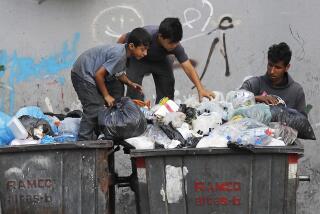Libyan rebels wave symbol of resistance
- Share via
Reporting from Benghazi, Libya — Nidal Sharif joins the Libyan revolution every day — in the fabric district.
The scraggly young man with a short, patchy black beard often has to scout out more than one shop to get what he needs. These days, everyone seems to be short on red, black or green fabric.
He buys at least one roll of each color every morning and takes them to a Sudanese tailor, who makes hundreds of the new (actually the old, pre-Moammar Kadafi) Libyan flag.
He then takes them to a printer, who stamps the white star and crescent in the middle.
By afternoon, Sharif, a 22-year-old economics sophomore, is on the main street to the Benghazi courthouse, where there are still daily protests, selling the flags out of the back of his beat-up blue Mazda, nationalist songs blaring from the speakers.
University classes have been suspended and there’s no demand for his regular side job of selling watches, so Sharif spends his days helping to fuel the revolution by making flags. He will continue, he said, until the flags cover the entire city and beyond.
“So when Moammar sees TV images of Benghazi, and sees it all with the new flag, maybe he will decide to leave, maybe,” Sharif said recently, maneuvering between potholes and other vehicles as he headed to the tailor shop with five rolls of fabric in the back. He wore a red sweatshirt for Nadi Al Ahly, the Benghazi soccer team hated by Kadafi, and a red kaffiyeh tied around his head.
Since the Libyan revolution began Feb. 17 and anti-government protesters seized on the former flag as their own, a cottage industry in Benghazi has sprung up to meet the demands of people wanting to hang it from their balconies, attach it to their cars or wave it during rallies.
At the fabric shops, only the black, red, green and white cloth is selling. Tailors do little other than sew thick strips of red, black and green together. Printers imprint the white star and crescent and make stickers and banners with revolutionary messages. Narrow black PVC piping works well as a flag pole.
“All of Benghazi is now in the service of making the flags,” said Ashraf Ahmad, 45, an Egyptian who owns a tailor shop. “They come here before they go to fight, and get a bunch and take them to the front lines.”
Sharif thought about making the flags on the first day of the protests, when he went to the courthouse. It was nothing like the images coming out of Egypt, where Tahrir Square was a sea of waving flags.
In the early days, some people made their own, flying what looked like a poorly made crafts project.
On Feb. 20, Sharif made his first batch, giving the fabric to immigrant African workers who set up old-fashioned sewing machines on the sidewalk. That same day, his uncle, an officer in the army, was killed when he refused to fire on protesters.
Hours before, he had called his older brother, telling him of the orders he had been given. “Don’t kill, better to die a martyr,” the older brother told him. “Don’t worry about your family and daughters.”
Sharif told the story as he drove to a print shop. Much of Benghazi’s stores have remained closed since the revolution began, and the metal security doors over shop windows are a constant reminder of Kadafi: By law they had to be painted all green, just like the flag.
“There’s no other country that has a flag with one color,” Sharif said. “He has made us hate the color green.”
At the print shop, Sharif and the shop owner shared a mission.
“You know, this work with the flag is our jihad,” Sharif told him.
“We work day and night, we work 24 hours for the flag,” Ahmad Ogli said in agreement. “Now it’s all work for the revolution.”
Sharif sells each flag for 5 dinars, although he also gives many of them away, saying he just breaks even.
At his spot recently, two men dressed in camouflage and headed into battle stopped by.
Sharif gave them a flag.
A car crammed with young men drove up. They were also heading to the front, even though they were unarmed.
“May God give you victory,” Sharif said and gave them a few flags. “I’m happy, because it’s like I’m going with them with the flag.”
More to Read
Sign up for Essential California
The most important California stories and recommendations in your inbox every morning.
You may occasionally receive promotional content from the Los Angeles Times.











